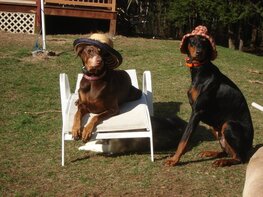
That piece is behavior modification, which does not just apply to dogs with behavioral problems. This can also be for active dogs to learn how to chill in environments that might be exciting in order to do their work or focus on training with you.
Desensitization is part of what is called threshold work. Desensitization is a process where you work the dog well below their threshold, which means you around an environment, stimulus, or trigger that will not cause the dog to reacte. Habituation is threshold work when the dog is worked at the point you expect some reaction from the dog, but the work is right at the point of being challenging not overwhelming. Finally, flooding is working the dog where you expect the dog to have a very hard time not reacting. With some dogs, you do not get to chose, because they are reactive or afraid of anything from the very beginning, and therefore the best thing to do is start where you can for that dog. Desensitization is therefore the lowest level of threshold work.
Threshold work is done by advancing commands (when ready after teaching in non distractions generally) or performing behavioral modification exercises around different environments, stimuli, or triggers. When you are doing this, you are looking for improved performance and skills. More importantly, however, you are watching for decreased signs of stress, fear or over the top excitement.
Perception modification takes these ideas further. In behavior modification, generally it is expected that the dog will ignore and be in control around various environments, stimulus, and triggers. In perception modification, the goal is to make a real positive change in the dog's feelings about these things to enjoyment. Usually a motivator, reward, or deep tissue massage is used to change certain feelings of fear or stress to the anticipation of enjoyment, after consistently using these strategies well over time.
So if you often feel your dog's fears or stressors are holding them back from the best life, use some behavior modification strategies to make it easier for your dog and yourself in the long run. Here are some things I regularly use with my personal dogs and client dogs:
- Sit on the Dog introduced by dog trainer, Margot Woods.
- Engagement games such as fetch to increase time and environmental distractions. Please do not rush this into distractions, and if you have a reactive dog, never play this game in an environment they will go intro reactivity. Move the needle as slowly as possible in that direction when playing toy games like this. I tend to follow Mike Ellis as an example of engaging your dog with games and toys.
- Introducing food in games and training, tends to have a soothing and calming effect on dogs, after the initial excitement and working through that to impulse control. Engaging your dog, not just using this as a reward but as an event, increases your relationship and importance to your dog. This, over time with proper application, makes the environment and distraction less of a focus for the dog. Mike Ellis is also a good source for ideas on this with both free videos and videos that you can pay for.
- "Name and Explain" and "Conditioned Relaxation" examples can be found on Kayce Cover's web pages, blogs and videos. Both of these can be used to make all sorts of situations less stressful for your dogs or other species of animals, as you will see in one of those links. Also because you are the source of all this good information and communication, your dog relationship becomes about trust and enjoyment.
Want to know more? Sign up for our newsletter to receive a list of the top three triggers and how to start to desensitize your dog to them.
 RSS Feed
RSS Feed